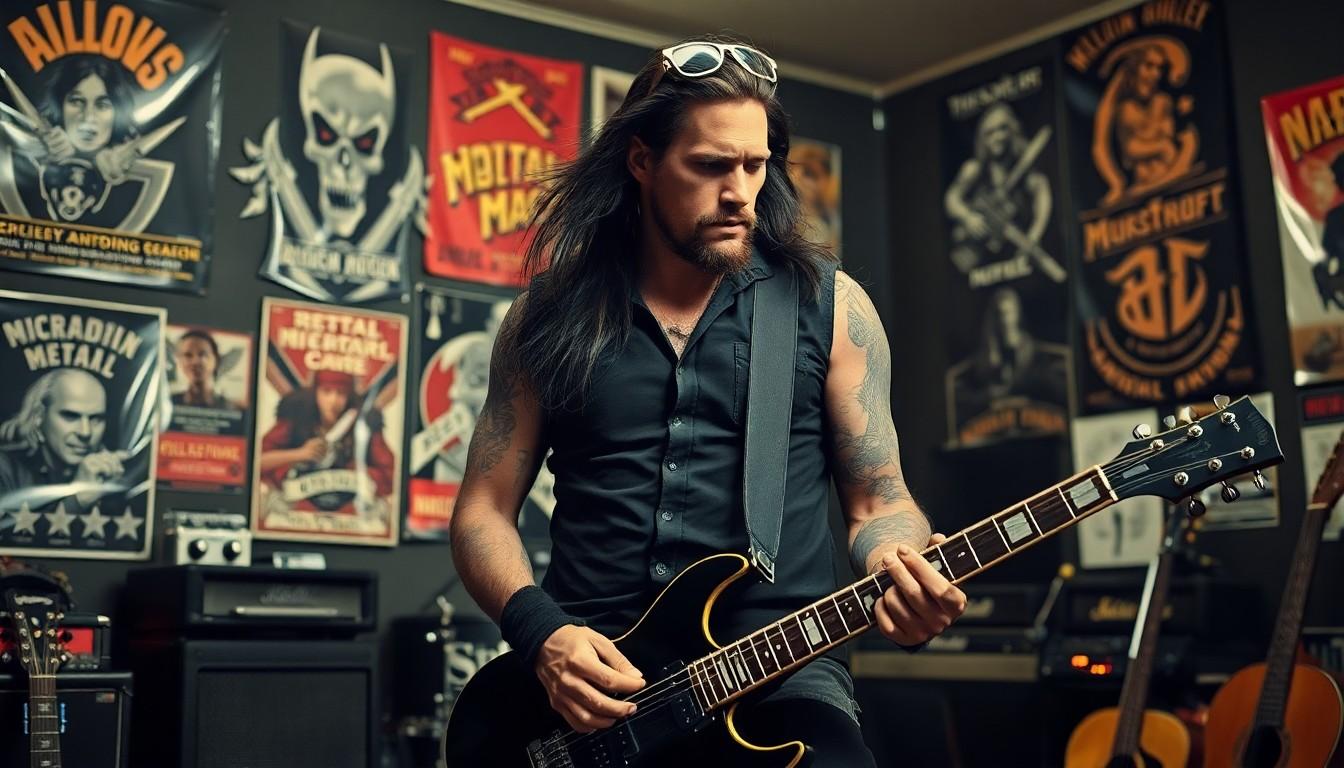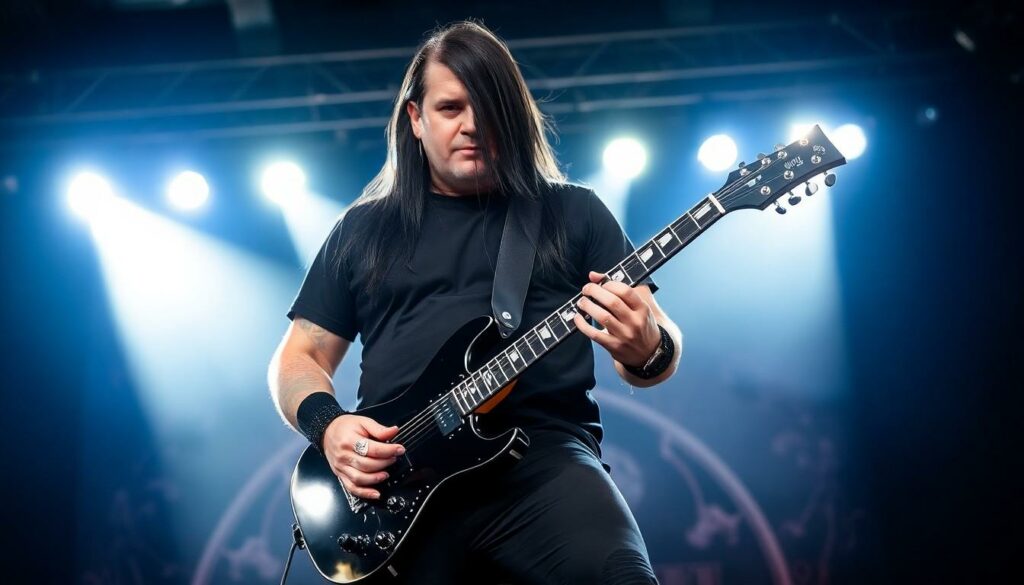Behind the menacing mask of Slipknot stands Mick Thomson (#7), one of metal’s most formidable guitarists. Known for his lightning-fast riffs and bone-crushing heaviness, Thomson has been terrorizing stages worldwide since joining the iconic band in 1996.
While most fans recognize him as the silent, intimidating figure in Slipknot’s lineup, Thomson’s guitar prowess speaks volumes louder than words. His signature playing style and technical precision have influenced countless musicians in the metal genre, earning him a spot among modern metal’s elite guitarists. When he’s not melting faces with his devastating riffs, he’s crafting custom guitars and pushing the boundaries of heavy music.
Mick Thomson
Mick Thompson emerged as Slipknot’s lead guitarist in 1996, establishing himself as #7 in the band’s numerical lineup system. Born on November 3, 1973, in Des Moines, Iowa, Thompson developed his distinctive guitar style through intense practice and dedication to metal music.
Standing at 6’4″, Thompson’s imposing presence matches his powerful guitar techniques on stage. His signature sound combines drop B tuning with precise alternate picking, creating the crushing riffs heard in iconic Slipknot tracks like “Psychosocial” and “Wait and Bleed.”
Technical proficiency marks Thompson’s playing style, characterized by complex chord progressions and intricate lead work. His gear collection includes custom Jackson and B.C. Rich guitars, specifically modified to achieve his heavy sonic palette.
| Career Highlights | Year |
|---|---|
| Joined Slipknot | 1996 |
| First Album with Band | 1999 |
| Signature Jackson Guitar Release | 2007 |
| Grammy Award (With Slipknot) | 2006 |
Beyond his role in Slipknot, Thompson contributes to guitar development with various manufacturers. His expertise extends to recording production, having engineered parts of several Slipknot albums in his personal studio.
Professional recognition includes features in Guitar World Magazine and multiple “Top Metal Guitarist” rankings. Thompson’s influence spans modern metal, inspiring guitarists through his combination of technical skill and sonic innovation.
Early Life and Musical Journey

Mick Thomson’s path to becoming a metal guitar virtuoso started in Des Moines, Iowa. His early exposure to music shaped his aggressive playing style and technical approach to guitar.
Growing Up in Iowa
Born on November 3, 1973, Thomson spent his formative years in Des Moines, surrounded by the Midwest’s burgeoning metal scene. His towering 6’4″ frame made him stand out among his peers during his school years at Des Moines’ Roosevelt High School. Thomson developed an interest in heavy music at age 10 after discovering bands like Black Sabbath and Judas Priest through local radio stations. His dedication to practicing guitar emerged during his teenage years, often spending 6-8 hours daily perfecting his technique.
Finding His Path in Music
Thomson’s musical journey began with local Des Moines bands in the early 1990s. He played in several underground metal groups including Body Pit, developing his signature aggressive playing style. His technical precision caught the attention of local musicians, leading to collaborations with future Slipknot members. In 1996, Thomson joined Slipknot, replacing their original guitarist. His mastery of drop B tuning and complex chord progressions became integral to the band’s distinctive sound. Prior to Slipknot, he worked as a guitar instructor, teaching advanced techniques to students while refining his own skills.
Career with Slipknot
Mick Thomson’s journey with Slipknot began in 1996 when he replaced their original guitarist Craig Jones. His technical prowess transformed the band’s sound through intricate riffing patterns layered with aggressive tones.
Joining the Band
Thomson joined Slipknot during a crucial transition period in 1996 through connections with drummer Joey Jordison. His addition brought a new level of technical proficiency to the band’s guitar work, particularly evident in the recording of their self-titled debut album in 1999. The band assigned Thomson the number seven mask, which evolved into his signature chrome design featuring sharp, aggressive features. His integration into Slipknot’s lineup coincided with the development of their distinctive nine-member format, establishing the foundation for their signature sound.
Notable Performances
Thomson’s first major performance with Slipknot occurred at Ozzfest ’99, introducing his devastating guitar work to mainstream audiences. The 2001 Iowa World Tour showcased his technical abilities through extended solos in tracks like “Disasterpiece” and “People = Shit.” Download Festival 2009 marked a highlight performance where Thomson’s guitar work dominated songs from the All Hope Is Gone album. His precision playing at Rock in Rio 2011 earned critical acclaim, with standout performances of “Psychosocial” and “Duality.” The 2015 Prepare for Hell Tour demonstrated Thomson’s evolution as a performer through complex arrangements in “.5: The Gray Chapter” material.
Musical Style and Equipment
Mick Thomson’s musical style combines technical precision with aggressive tones, creating a signature sound that defines Slipknot’s heavy metal sound. His equipment choices reflect his dedication to achieving specific tonal qualities for both studio recordings and live performances.
Guitar Technique
Thomson employs precise alternate picking patterns at high speeds while maintaining exceptional clarity in his playing. His technique features palm-muted power chords mixed with complex lead passages executed through strict downpicking. He incorporates chromatic runs combined with diminished scales to create dissonant harmonies characteristic of Slipknot’s sound. Thomson’s playing emphasizes rhythm accuracy through synchronized double-tracking methods in studio recordings. His lead work showcases controlled feedback manipulation paired with precise vibrato techniques.
Signature Instruments
Thomson plays custom Jackson Soloist models featuring mahogany bodies with maple necks. His primary guitars include EMG 81/85 active pickups wired to a single volume control. The instruments feature specialized Dunlop strings gauged .011-.058 for enhanced low-end response. His signature Jackson seven-string model comes equipped with a Floyd Rose tremolo system locked in fixed position. Thomson utilizes Ibanez Tube Screamer pedals running into Mesa/Boogie Triple Rectifier amplifiers for live performances. His rack system includes noise gates custom-modified by ISP Technologies specifically for his setup.
Impact on Heavy Metal
Mick Thomson’s technical precision revolutionized metal guitar playing through his work with Slipknot. His innovative approach to rhythm guitar combined with devastating lead techniques established new standards for modern metal guitarists.
Influence on Modern Metal
Mick Thomson’s signature playing style sparked a transformation in modern metal guitar techniques. Metal guitarists adopted his precise alternate picking methods to achieve crystal-clear articulation at high speeds. His approach to palm muting created the foundation for many contemporary metal rhythm sections, particularly in tracks like “Psychosocial” where tight chugging meets complex lead work. Leading metal publications credit Thomson’s innovative use of drop B tuning for popularizing lower-pitched guitar tones across the genre. Guitar manufacturers incorporated his specifications into production models, making his preferred setup accessible to emerging musicians. Notable metal bands cite Thomson’s technical proficiency as inspiration, including Trivium’s Matt Heafy who integrated similar precision-based techniques into his playing. Top guitar programs now teach Thomson’s methodical practice routines to develop speed with accuracy. His impact extends through signature gear developments, including EMG pickup configurations that became standard in modern metal guitar construction.
Notable Side Projects
Mick Thomson launched the MT-100R guitar pickups in collaboration with Seymour Duncan in 2014, creating a signature sound profile tailored for metal genres. His partnership with Jackson Guitars produced three signature models: the MT1 Soloist (2007), MT2 Pro Series (2012) and the MT7 Seven-String (2016).
Equipment development projects include:
- Custom audio rack system design with Mesa Engineering (2008)
- Signature guitar string set with Dunlop Manufacturing (2011)
- Limited edition custom guitar cases with SKB Corporation (2013)
- Signature MT EMTY guitar amplifier with Rivera Amplification (2015)
Thomson operates a private recording studio in Des Moines where he engineers demos for emerging metal bands. His production credits include:
| Year | Artist | Project Role |
|---|---|---|
| 2010 | Path of Pain | Producer/Engineer |
| 2012 | Blood Synthesis | Guitar Production |
| 2015 | Neural Void | Mix Engineer |
| 2018 | Crisis Protocol | Producer/Mixer |
Guest appearances showcase Thomson’s versatility beyond Slipknot:
- Featured guitarist on Malevolent Creation’s “Decimated” (2009)
- Lead guitar solo on Machine Head’s “Bloodstone & Diamonds” (2014)
- Guitar tracking for Soulfly’s “Ritual” album (2018)
- Collaboration with Testament on “Brotherhood of the Snake” (2016)
His instructional content includes technique videos for Guitar World Magazine digital platforms starting in 2013. Thomson contributed to the “Metal Guitar Mastery” video series in 2017, demonstrating his signature picking patterns rhythmic approaches.
Mick Thomson’s legacy as Slipknot’s lead guitarist extends far beyond his remarkable technical skills and crushing riffs. His dedication to perfecting his craft has not only elevated Slipknot’s sound but also set new standards in metal guitar playing.
Through signature gear development collaborations teaching contributions and studio work Thomson continues to shape the future of metal music. His influence resonates through generations of guitarists who’ve adopted his techniques and sought to emulate his precision and power.
From a passionate young musician in Des Moines to a globally recognized metal icon Thomson’s journey exemplifies the impact that unwavering dedication and technical mastery can have on an entire genre.



